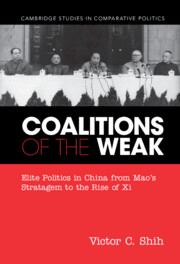Book contents
- Coalitions of the Weak
- Cambridge Studies in Comparative Politics
- Coalitions of the Weak
- Copyright page
- Dedication
- Contents
- Figures
- Tables
- Acknowledgments
- 1 Introduction
- 2 Coalition of the Strong
- 3 “Counterrevolutionary Splittists” in Mao’s Ruling Coalition
- 4 The Scribblers Mafia
- 5 Realizing the Coalition of the Weak
- 6 The Collapse of the Coalition of the Weak and Power Sharing in the 1980s
- 7 Weak Successors
- 8 Conclusion and the Future of the Chinese Communist Party
- References
- Index
6 - The Collapse of the Coalition of the Weak and Power Sharing in the 1980s
Published online by Cambridge University Press: 26 May 2022
- Coalitions of the Weak
- Cambridge Studies in Comparative Politics
- Coalitions of the Weak
- Copyright page
- Dedication
- Contents
- Figures
- Tables
- Acknowledgments
- 1 Introduction
- 2 Coalition of the Strong
- 3 “Counterrevolutionary Splittists” in Mao’s Ruling Coalition
- 4 The Scribblers Mafia
- 5 Realizing the Coalition of the Weak
- 6 The Collapse of the Coalition of the Weak and Power Sharing in the 1980s
- 7 Weak Successors
- 8 Conclusion and the Future of the Chinese Communist Party
- References
- Index
Summary
After Mao’s passing in September 1976, the coalition that Mao had put in place at the end of his life, which was composed Cultural Revolution radicals with little revolutionary experience, even more junior officials like Wu De and mass representatives, the tainted Fourth Front Army (FFA) group, and a handful of trusted First Front Army veterans like Ye Jianying and Wang Dongxing, took over the People’s Republic of China. An uneasy truce persisted for a very short time before the Gang of Four had alarmed Hua Guofeng by challenging his role as the anointed successor, which compelled him to seek more drastic solutions (Zhang 2008b: 263). In this decisive moment, the FFA swung behind Hua, thus sealing the Gang of Four’s fate, but Hua also became very dependent on FFA veterans. His dependence on military veterans with vastly more experience and greater networks ultimately also brought about his downfall. Within two years of Mao’s death, none of the potential successors Mao had put into place just prior to his death survived as powerful figures in the party. The Gang of Four had ended in jail, while Hua was sidelined at the third plenum in 1978. Even FFA veteran Li Desheng, who had served as vice chairman of the party for a short while, ended his career in the 1980s as the head of the National Defense University (Zhu 2007: 425). Except for key members of the FFA group, the vast majority of Mao’s coalition of the weak had ended in jail or in retirement by the early 1980s. His legacy of continuous revolution also was completely expunged from the party ideology in favor of a single-minded focus on economic development.
Keywords
- Type
- Chapter
- Information
- Coalitions of the Weak , pp. 135 - 152Publisher: Cambridge University PressPrint publication year: 2022



